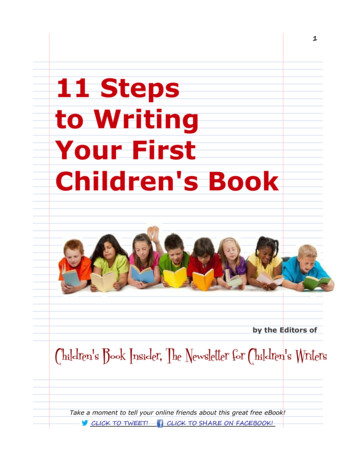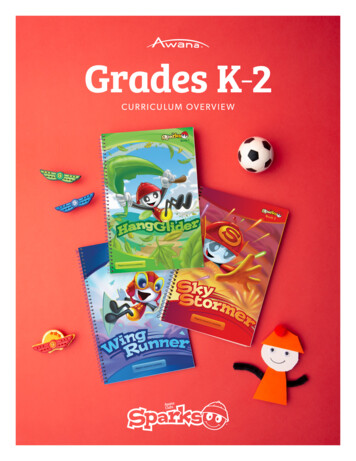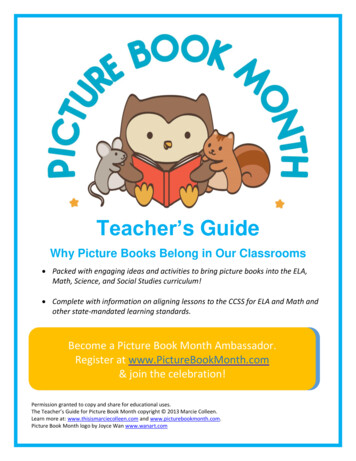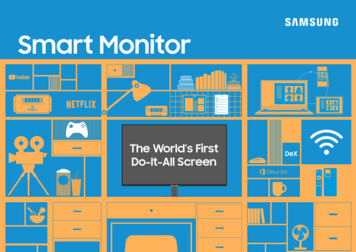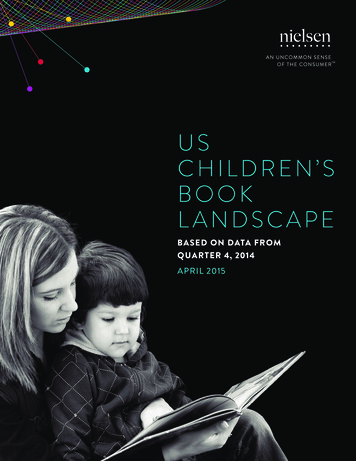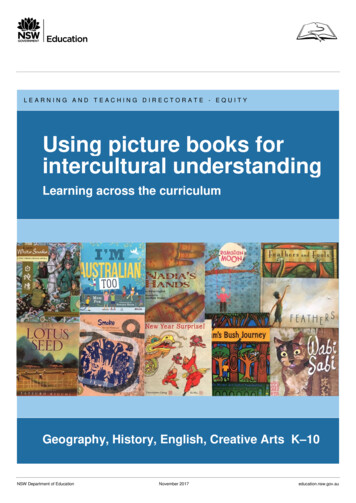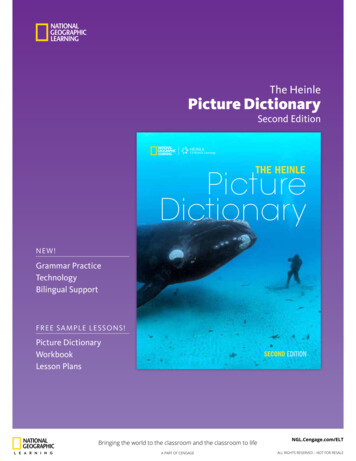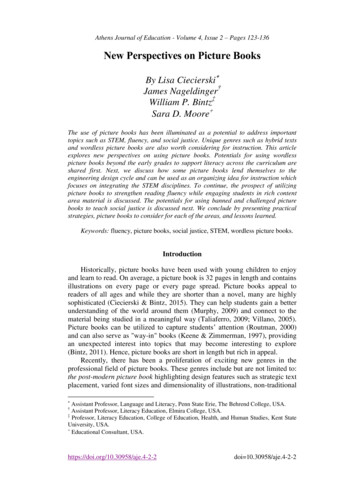
Transcription
Athens Journal of Education - Volume 4, Issue 2 – Pages 123-136New Perspectives on Picture BooksBy Lisa Ciecierski James Nageldinger†William P. Bintz‡Sara D. Moore The use of picture books has been illuminated as a potential to address importanttopics such as STEM, fluency, and social justice. Unique genres such as hybrid textsand wordless picture books are also worth considering for instruction. This articleexplores new perspectives on using picture books. Potentials for using wordlesspicture books beyond the early grades to support literacy across the curriculum areshared first. Next, we discuss how some picture books lend themselves to theengineering design cycle and can be used as an organizing idea for instruction whichfocuses on integrating the STEM disciplines. To continue, the prospect of utilizingpicture books to strengthen reading fluency while engaging students in rich contentarea material is discussed. The potentials for using banned and challenged picturebooks to teach social justice is discussed next. We conclude by presenting practicalstrategies, picture books to consider for each of the areas, and lessons learned.Keywords: fluency, picture books, social justice, STEM, wordless picture books.IntroductionHistorically, picture books have been used with young children to enjoyand learn to read. On average, a picture book is 32 pages in length and containsillustrations on every page or every page spread. Picture books appeal toreaders of all ages and while they are shorter than a novel, many are highlysophisticated (Ciecierski & Bintz, 2015). They can help students gain a betterunderstanding of the world around them (Murphy, 2009) and connect to thematerial being studied in a meaningful way (Taliaferro, 2009; Villano, 2005).Picture books can be utilized to capture students’ attention (Routman, 2000)and can also serve as "way-in" books (Keene & Zimmerman, 1997), providingan unexpected interest into topics that may become interesting to explore(Bintz, 2011). Hence, picture books are short in length but rich in appeal.Recently, there has been a proliferation of exciting new genres in theprofessional field of picture books. These genres include but are not limited to:the post-modern picture book highlighting design features such as strategic textplacement, varied font sizes and dimensionality of illustrations, non-traditional Assistant Professor, Language and Literacy, Penn State Erie, The Behrend College, USA.Assistant Professor, Literacy Education, Elmira College, USA.‡Professor, Literacy Education, College of Education, Health, and Human Studies, Kent StateUniversity, USA. Educational Consultant, USA.†https://doi.org/10.30958/aje.4-2-2doi 10.30958/aje.4-2-2
Vol. 4, No. 2Ciecierski et al.: New Perspectives on Picture Booksplot structure, all of which invite readers to read complex text in strategicways. Additionally, hybrid picture books integrate verse and prose, multiplesources of information, mixtures of styles, and multiple functions. Thesegenres offer readers new ways of making meaning. They may also serve as aninvitation to educators and readers to consider new perspectives and newpotentials for utilizing these types of picture books as well as many other typesof picture books for instruction.The purpose of this article is to inspire readers, teachers, and teachereducators to explore new perspectives and their potentials for making meaningthrough the transformative nature of the picture book. It is comprised of foursections to represent four different perspectives. We begin by presenting thepotential of using Wordless Picture Books and continue by exploring thepotential of using picture books to teach Science Technology, Engineering, andMathematics. Next, we share about utilizing patterned and predictable text inpicture books to increase reading fluency while simultaneously promotingcontent area learning. The fourth perspective demonstrates the potency of usingbanned and challenged picture books to teach social justice issues. Each sectioncontains a description of the perspective, multiple books highlighting examplesof the perspective, and discussion about how utilizing this type of picture bookmay lend to instruction. We conclude by sharing our final thoughts.New Perspectives on Wordless Picture Books"Wordless picture books prepare students for a solid foundation inreading because they stimulate oral communication and foster literacy"(Gitelman, 1990, p, 525).What is a Wordless Picture Book?A wordless book is simply a "picture book with no text" (Harris &Hodges, 1995, p. 282). It can, of course, be read fast and often is by manyreaders, both young and old. However, it should not be read fast because awordless picture book is anything but simple. It is a complex, time-honored,literary genre, or art form, that has played a critical role in helping youngchildren develop a positive disposition about books, reading, and learning.There are a plethora of wordless picture books for readers of all ages.Some of our very favorites are highlighted in Table 1.124
Athens Journal of EducationMay 2017Table 1. Wordless Picture BooksChalk (Thomson, 2010).Float (Miyares, 2015).Flotsam (Wiesner, 2006).Mirror (Baker, 2010).Mysteries of Harris Burdick (Van Allsburg, 1984).One Scary Night (Guillopp, 2004).Return (Becker, 2016).The Arrival (Tan, 2007).The Little Red Fish (Yoo, 2007).The Zoo (Lee, 2007).Trainstop (Lehman, 2008).Unspoken (Cole, 2012).Wave (Lee, 2008).Window (Baker, 1991).Zoom (Banyai, 1998).Using Wordless Picture BooksTraditionally, parents and teachers have used wordless picture books in avariety of ways and for a multitude of reasons. At home, parents have usedthese kinds of books for lap reading, and, of course, bedtime reading. Theseexperiences allow parents and children to engage in imaginative, enjoyable,entertaining, and, yes, sometimes surprising, conversations about engagingstories, lovable characters, artful illustrations, and interesting designs, e.g.board books, pop-up books, etc. They also help parents introduce children tothe inherent beauty, profound artistry, and immense value of picture books, ingeneral, and wordless picture books, in particular. Most importantly, thesekinds of social literary experiences have long-term effects on children. Longterm, they pave the way, naturally, smoothly, and effectively, for children toultimately become life-long members of the literacy club (Smith, 1988).In school, teachers use wordless picture books to introduce a literary genreor author’s craft, namely, visual storytelling, the telling of stories only throughvisual images. Wordless picture books are excellent to highlight four importantnotions about readers and texts: 1) readers don’t receive meaning from texts,they create it, 2) texts have both surface and deep levels of meaning, 3) surfacelevel meanings are based on what the text says, whereas deep levels ofmeaning are based on what the text means; the latter requires understandingand interpretation, 4) texts have the potential for multiple interpretations(Ramos & Ramos, 2011; Sanderson, 2011) and readers need to value theperspectives of others because they enrich their own understandings(Rosenblatt, 1978/1994).Interestingly, readers of wordless picture books use the same strategies aswhen reading texts with words (Pantaleo, 2007). They use prior knowledge,make intertextual connections, and consider other perspectives (Crawford &Hade, 2000). Wordless picture books help readers create meaning throughrigorous observation use oral and written language to discuss the story the125
Vol. 4, No. 2Ciecierski et al.: New Perspectives on Picture Bookspictures represent (Jalongo, Dragich, Conrard, & Zhang, 2002). They promptreaders to tell interpret the story in their own words, that is, to personalize thestory with an authentic voice (Rosenblatt, 1991).From a semiotic perspective, typical picture books, those with words andillustrations, invite readers to use both sign systems to crate meaning (Siegel,1995). Wordless picture books, however, are unique in that they allow readersto use one sign system, the illustrations, to create meaning. Interestinglyenough, Berghoff (1993) found that even when text is available, readers useillustrations and drawings to create meaning beyond just the written text.Simply stated, illustrations are critically important for readers to createmeaning, whether it is in a typical picture book or a wordless one (Pantaleo,2007).Ultimately, the goal of typical picture books and wordless picture books isthe same, to help readers become more engaged in and attentive of any text(Sulentic-Dowell, Beal, & Capraro, 2006). Wordless picture books may beconsidered as one of the most beautiful art forms in literature and have muchpotential for sparking new conversations about new perspectives.Wordless picture books may stimulate interest as well as conversationamong readers. Exploring the potentials of award winning picture books toengage and instruct students in the science, technology, engineering, andmathematics may be enjoyable for children may also be used as an invitation toexplore and make sense of the world they inhabit.New Perspectives on Picture Books Related to Science,Technology, Engineering, & Mathematics (STEM)"Scientists investigate that which already is;engineers create that which has never been."—Albert EinsteinWhat is STEM?The engineering design cycle can be used as an organizing idea forinstruction which focuses on integrating the STEM disciplines (see Morgan &Ansberry, 2015; Lachapelle, Sargianis, & Cunningham, 2013). STEM is anabbreviation often used for four disciplines: Science, Technology, Engineering,and Mathematics. Science and mathematics are familiar disciplines and wehave briefly described engineering above. Technology is subject to the greatestmisconception in our modern era. The Standards for Technological Literacy(ITEA, 2000) define technology as, "the innovation, change, or modification ofthe natural environment in order to satisfy perceived human wants and needs"(p. 242). This reminds us that technology is as much the chair in which we sitas it is the computer on which we type. STEM understanding and STEMthinking is important to us as literate members of society when we makehealth-care decisions or consider environmental issues when voting. STEM is126
Athens Journal of EducationMay 2017equally important in many of the fastest growing careers.As STEM becomes more and more prevalent, so do the books that maypotentially connected to this concept. Table 2 shares just some of these thatmay be used in the classroom.Table 2. Picture Books for STEMAnything is Possible (Belloni & Trevisan, 2011).Emmanuel’s Dream: The True Story of Emmanuel Ofosu Yeboah (Thompson, 2015).Engineering Elephants (Hunt & Pantoya, 2010).Engineering the ABC’s: How Engineers Shape Our World (Novak, 2010).George Ferris: What a Wheel! (Lowell, 2014).Honda, The Boy Who Dreamed of Cars (Weston, 2008).How Machines Work (Macaulay, 2015).Iggy Peck, Architect (Beaty, 2007).Mr. Ferris and His Wheel (Gibbs Davis, 2014).Papa’s Mechanical Fish (Fleming, 2013).Rocks, Jeans, and Busy Machines: An Engineering Kids Storybook (Rivera & Rivera,2010).Rosie Revere, Engineer (Beaty, 2013).The Fantastic Ferris Wheel: The Story of Inventor George Ferris (Kraft, 2015).The Inventor’s Secret: What Thomas Edison Told Henry Ford (Slade, 2015).The New Way Things Work (Macaulay, 1988).Using Picture Books Related to STEMThe designed world surrounds us. Our clothing, our homes, the tools wedepend on each day are all the result of engineers designing solutions toproblems which make our lives better. Our clothes keep us warm; our homesprotect us from the elements; our digital tools connect us. High-quality andaward-winning literature, particularly picture books, can be used to teachchildren (and adults) about the engineering design process.In the picture book, The Most Magnificent Thing (Spires, 2014), theheroine has a vision of a most magnificent thing she will make. Using a widerange of found resources and over the course of many iterations, she brings hervision to life. This story is about the engineering design process, the cyclethrough which engineers design solutions to problems (Crismond & Adams,2012). In this process, engineers work to define and understand the problem,develop possible solutions, build and test models or prototypes, and then reflectand redesign. There typically is no one best solution; rather, engineers work onrefining the solution to be the best possible one under the given criteria (whatwill make this successful) and constraints (what limits of space, money, orother resources are there). Picture books such as The Most Magnificent Thingintroduce learners to key STEM ideas and STEM thinking.From a literacy perspective, these picture books are highly engaging piecesof literature. The fiction/narrative books are excellent examples of the powerand potential of realistic fiction. They have engaging story lines, fascinatingcharacters, intriguing settings, and beautiful, if not artistic, illustrations.127
Vol. 4, No. 2Ciecierski et al.: New Perspectives on Picture BooksTogether, these literary elements create a positive and enjoyable readingexperience. The nonfiction/informational books are also excellent readingresources. They include accurate information through carefully crafted text,appropriate text structures (chronological sequence, cause and effect,comparison and contrast, most important to least important, etc.), and attractiveillustrations, models, and graphs. Together, these text features makeinformation interesting and understandable for readers.Other picture books can be used to introduce students to engineeringdesign challenges which other children have solved or to challenges ourstudents might work on. One example is The Boy Who Harnessed the Wind(Kamkwamba & Mealer, 2012) which tells the story of William Kamkwamba,a young boy in Malawi who dreamed of bringing a windmill to his village. Thewindmill would provide electricity and could pump water to support the cropsduring drought so the community does not starve. Much as our heroine in TheMost Magnificent Thing, William collects materials from his community andworks through many iterations of his windmill until he finds success. Thisstory could be used to introduce the idea of food deserts, areas in urbancommunities in the US where there is no access to fresh produce. In theseareas, there is no land for community gardens and there are no marketsbringing fresh produce to the community. What sort of gardening system couldstudents design which would allow residents of this community to grow theirown produce within the constraints of their community?These questions have great potential of stimulating students’ thoughtprocesses. Utilizing picture books as a foundation to stimulate this way ofthinking certainly pertains to STEM. It also relates to using hybrid texts toteach fluency in the content areas.New Perspectives on Hybrid Texts and Their Use to Teach Fluency acrossthe Content AreasWhat are Hybrid Texts?Hybrid picture books integrate verse and prose, multiple sources ofinformation, mixtures of styles, and multiple functions. Characteristic of hybridtext are elements of information in narrative form and a strong illustrative/textrelationship.There are many different types of hybrid texts. We have highlighted bookswhere authors have utilized the hybrid text format to integrate both facts,vocabulary, and even quotes. We have chosen books that utilize the traditionalhybrid text format of blending fiction and nonfiction through a story withinformational facts as well as books where the author shares poems andhighlighting informational facts that connect to these poems in Table 3.128
Athens Journal of EducationMay 2017Table 3. Hybrid Texts for Fluency in the Content AreasA Drop Around the World. (McKinney, 1998).Cucumber Soup (Krudwig, 1998).Dinner at the Panda Palace (Calmenson & Westoctt, 1995).Flight of the Honey Bee (Huber, 2013).Gotta Go! Gotta Go! (Swope, 2004).Haiku Hike (St. Mary’s Catholic School, 2005).One leaf rides the wind. (Mannis, 2002).Out of this world (Skylansky, 2012).Python (Cheng, 2012).Thomas Jefferson Builds a Library (Rosenstock, 2013).Winter bees & Other Poems of the Cold (Sidman, 2014).The Wright Brothers (Edwards, 2003).Using Hybrid Texts to Teach Fluency across the Content AreasRecent introduction of new genres in children’s and adolescent’s literaturehave opened up a new and exciting landscape in reading pedagogy with thepotential for helping struggling readers increase their reading fluency whileaccessing grade level content. One of these new genres is called hybrid texts(Maloch & Bomer, 2013).This genre offers elementary and middle-grades reading and content areateachers a new way to think about teaching reading, as well as using reading asa tool to teach across the content areas. As a new genre, the power andpotential of hybrid text is immense but virtually unexplored. One of the leastexplored dimensions is the relationship between hybrid text and oral readingfluency. Once thought to be a problem relegated to the lower grades, recentresearch has show reading fluency to be an issue extending middle and highschool as well (Paige, Rasinski, & Magpuri-Lavell, 2012; Rasinski & Padak,2005).Much research indicates that authentic literature, especially high-qualityliterature, is an effective tool to teach content area material across thecurriculum (Albright, 2002; Bean, 2003; Bintz, 2011; Ciecierski & Bintz;Murphy, 2009; Palmer & Stewart, 1997). At the same time there is a body ofempirical research that clearly indicates a correlation exists between oralreading fluency and silent reading comprehension (Benjamin &Schwanenflugel, 2010; Fuchs, Fuchs, Hosp, & Jenkins, 2001; Rasinski, Rikli,& Johnston, 2009). Patterned and predictable text has been shown to be aneffective way to increase reading fluency (Bridge & Burton, 1982; Rhodes,1979). Patterned and predictable hybrid text offers rich content areapossibilities for struggling readers while building fluency beyond the earlygrades. The integration of the patterned and predictable hybrid text elementswith narrative information and a strong illustrative/text relationship offerpotentials for simultaneous fluency development and content area learning.These Hands (Mason, 2015) is a powerful book that was used as afoundation to show how hybrid texts may be utilized in the classroom. It beginswith Vance. Vance jokes with some of the cast members backstage. In a few129
Vol. 4, No. 2Ciecierski et al.: New Perspectives on Picture Booksminutes, he and some of his classmates will be performing a Readers Theatrepiece for their sixth grade class. He’s nervous but not overly so. Less than ayear ago reading aloud in front of people would have been the last thing hewanted to do. The way he plodded word for word through text was as painfulfor others to listen to as it was for him to undertake. Today, he looks forward toit. Not incidentally, the script the teacher has chosen was adapted fromMargaret Mason’s hybrid text These Hands (Mason, 2015), a powerfulintergenerational story, in which an African American man tells his grandsonabout a time when, despite all the wonderful things his hands could do, theycould not touch bread at the Wonder Bread factory. Based on actual stories ofbakery union workers Mason’s patterned and predicable text combines theproven connection of oral reading fluency to reading comprehension with theintroduction of rich content area material. Young Joseph learns that peoplejoined their hands together to fight discrimination so that one day, theirhands—Joseph’s hands—could do anything at all in this whole wide world.The genre of hybrid texts has unlimited potential for use in content areaclassrooms. As discussed, viewing the use of hybrid texts if various ways maylead educators to considering their use to address the topic of fluency. Thisextended way of thinking is important to consider in education. Similarly, isthe consideration of challenged and banned books to address social justice.New Perspectives on Picture Books as Challenged and Banned BooksWhat are Challenged and Banned Books?Challenged or banned books are books that have been questioned forreasons such as violence, offensive language, and containing material that isbelieved to be sexually explicit. Evans (2015) shares that these books are"demanding, dangerous, and difficult" as well as "fascinating, frightening,frustrating" and even a risk (p. xliiv). She continues to share the emotions thatare may be felt in response to these books. They are not books that make usfeel warm and fuzzy. It is actually the challenge and the complexity of thesebooks which may appeal to some while challenging others. Consequently,these books might also be perceived as being unsuited for an age group.Many challenged or banned books are novels. However, consideringpicture books that are banned has great implications for instruction. Table 4shares additional texts that may be considered.130
Athens Journal of EducationMay 2017Table 4. Challenged and Banned BooksDenver (McKee, 2010).Home and Away (Marsden, 2008).Nappy Hair (Herron, 1997).Rose Blanche. (Gallaz & Innocenti, 1985).Smoky Night. (Bunting, 1999).The Enemy (Cali, 2009).The Girl in Red (Frisch, 2012).The Red Tree (Tan, 2000).Where the Wild Things Are (Sendak, 1963).Wolves (Gravett, 2006).Using Challenged and Banned BooksFamiliarizing ourselves with the plot of the book as well as the reasonswhy these books were challenged or banned might engage us in consideringinteresting points and potential teaching implications. While adults often feelthat these books are challenging, it is they, who have problems coping withthese types of texts. Young children have to deal with these types of problemson a daily basis in their own life and find benefit to reading these books(Evans, 2015). Three books are presented here by first sharing the plot, sharingthe reason why the book was banned or challenged, and then sharing theteaching implications.Nasreen’s Secret School: A True Story from Afghanistan (Winter, 2009) isbased on the true story of Nasreen. Nasreen lives in Afghanistan, under Talibanrule, and stopped talking when her parents disappear. Her grandmother enrollsher in a secret school. At the school, Nasreen discovers a world of art,literature, and history, despite the prohibition of learning by the Taliban.Nasreen’s Secret School: A True Story from Afghanistan was challengedbecause of its religious viewpoint, violence, and a claim that the book isunsuited to the age group. This is interesting for several reasons. First, there arereferences to children reading the Koran, but there is not any persuasionattempted by the author to encourage the reader to believe in any particularreligion. The story line is told from a historical perspective. The violence in thebook is inferred. The Taliban comes to the secret school and find girls readingthe Koran. This is allowed, so the Taliban leave. Readers’ may infer that theconsequence to the Taliban finding the girls learning would be violent;however, this is not explicit. Therefore, it would depend on the age andmaturity of the reader how this scene is perceived. This may also lead to theappropriateness of the book being shared with readers grades one through four.Louise Rosenblatt proposes that a readers’ interpretation of a text dependson what his or her experiences are (1978/1994). With this thought in mind, it isup to the reader to bring meaning to the text after the author has written it. Ifthe reader does not have the background knowledge to infer the violence thatmay occur if the Taliban finds out about the secret school, the violence may notbe interpreted. Although students’ comprehension relies on their backgroundknowledge, this book may be an excellent choice to inspire conversation on131
Vol. 4, No. 2Ciecierski et al.: New Perspectives on Picture Bookssocial justice issues such as the freedom of religion, as well as women’s rightsand how these rights did and still do differ from culture to culture and countryto country.The second picture book and Tango Makes Three (Richardson & Parneli,2005) tells the true story of three penguins who live in the Central Park Zoolocated in New York City. Roy and Silo are two male penguins who appear toenjoy each other’s companionship. They are often seen swimming and playingtogether in the water. When the other penguins in the zoo begin hatching eggs,Roy and Silo cuddle and share a nest like the other couples. They even bring anegg-shaped rock back to their nest. A zookeeper who had been watching thepenguins decides to give Roy and Silo their own egg to nurture, and the twofathers do a wonderful job doing just that. Their son, Tango, is born and lovedjust as the other chicks.This book was challenged because of homosexuality, religious viewpoint,and a claim that the book was unsuited to an age group. There are severalinteresting points to consider.First, the book is based off of a true story. Roy, Silo, and Tango are realpenguins and so is their story. The book is written for children in preschoolthrough grades three. Again, considering Rosenblatt’s transactional readingtheory previously discussed would influence the readers’ interpretation of thispicture book.While the topic of homosexuality is difficult and sometimes controversial,many children live in a world where homosexuality is part of their life.Children and adolescents around them may not know how to haveconversations about this topic and may question what is right and what iswrong. From a social justice perspective, this book might be considered as a"way-in" to this conversation.Finally Hiroshima No Pika (Maruki, 1980) shares the story of a sevenyear-old girl having breakfast with her family. It seems like an ordinarymorning until "it" happens. Told from the mother’s perspective, this is the storythat brings the bombing of Hiroshima to life. The illustrations and language aregraphic to portray this even in a realistic manner. The reader is brought into thestory to experience the pain and turmoil of the event.This book was challenged because it does not represent war as beingglorious. It is also challenged for not being appropriate for its intendedaudience. However, it was not written with the intention of being shared withyoung children. The suggested audience is grade four and above. While thisbook is indeed graphic, it shares a perspective of the event that is realistic. Waris not glorious, and it is important to recognize and understand historical eventsso these events do not repeat themselves.Picture books are not written simply for young children and have greatpotential for being utilized to enhance the learning and conversations of olderstudents. While many may challenge particular books in the attempt to protectstudents, considering these books as a "way-in" to difficult but importantconversations is worth considering. They may also inspire interest into topicsunderexplored but important for our future.132
Athens Journal of EducationMay 2017Final ThoughtsWhile picture books are often short, they have tremendous potential ofbeing complex and inspiring sophisticated thinking. We have highlighted fourperspectives to consider: wordless picture books, picture books related toscience, technology, engineering, & mathematics, hybrid texts to teach fluencyacross the content areas, and challenged and banned picture books. We hopethat these will serve as an invitation to consider other forms of picture booksand the many potential they offer to teachers and to students alike.ReferencesAlbright, L. (2002). Bringing the Ice Maiden to life: Engaging adolescents in learningthrough picture book read-alouds in the content areas. Journal of Adolescent &Adult Literacy, 45(5), 418 – 428.Bean, T. (2003). Using young-adult literature to enhance comprehension in thecontent areas.Naperville, IL: Learning Point Associates.Benjamin, R. G., & Schwanenflugel, P. J. (2010). Text complexity and oral readingprosody in young readers. Reading Research Quarterly, 45(4), 388-404.Berghoff, B. (1993). Moving toward aesthetic literacy in first grade. In D. Leu & C.Kinzer (Eds.), Examining central issues in literacy research, theory, and practice(42nd Yearbook of the National Reading Conference) (pp. 217-226). Chicago, IL:National Reading Conference.Bintz, W.P. (2011). "Way-In" books encourage exploration in middle gradesclassrooms. The Middle School Journal, 42(3), 34 – 45.Bridge, C., & Burton, B. (1982). Teaching sight vocabulary through patternedlanguage materials. In J. A. Niles & L.A. Harris (Eds.), New inquires in readingresearch and instruction (pp. 113-123). Washington, DC: National ReadingConference.Ciecierski, L. & Bintz, W.P. (2015). Developing a challenging and integratedcurriculum. Middle School Journal 46 (5), 17 – 25.Crawford, P., & Hade, D., (2000). Inside the picture, outside the frame: Semiotics andthe reading of wordless picture books. Journal of Research in ChildhoodEducation, 15(1), 66-80.Crismond, D.P., & Adams, R. S. (2012). The informed design teaching and learningmatrix. Journal of Engineering Education, 101(4), 738-797.Evans, J. (2015). Challenging and controversial picture books: Creative and criticalresponses to visual texts. New York: Routledge.Fuchs, L. S., Fuchs, D., Hosp, M. K., & Jenkins, J. R. (2001). Oral reading fluency asan indicator of reading competence: A theoretical, empirical, and historicalanalysis. Scientific Studies of Reading, 5(3), 239-256.Gitelman, H. (1990). Using wordless picture books with disabled readers. TheReading Teacher, 43(7), 525.Harris, T.L., & Hodges, R.E. (Eds.) (1995). The literacy dictionary: The vocabulary ofreading and writing. Newark, DE: International Reading Association.ITEA. (2000). Standards for Technological Literacy: Conte
strategies, picture books to consider for each of the areas, and lessons learned. Keywords: fluency, picture books, social justice, STEM, wordless picture books. Introduction Historically, picture books have been used with young children to enjoy and learn to read. On average, a picture book is 32 pages in length and contains
